Beyond the town of Sintra is the Natural Park of Sintra-Cascais, offering a continuation of the fantastical buildings and natural beauty for which the town is revered. But getting around the Natural Park can be a little trickier than expected without a car.
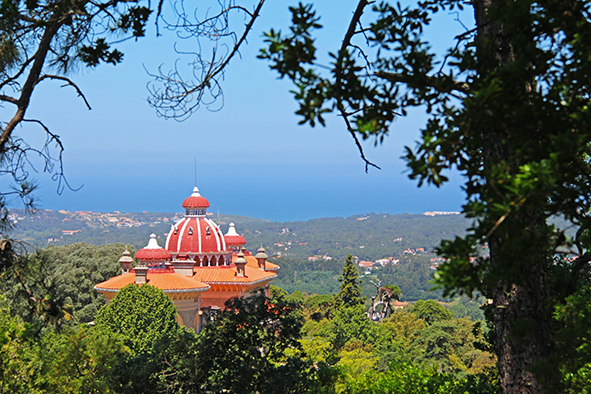
Looking out towards the Atlantic over the rooftop of the Palace of Monserrate (Photo: Paul Stafford)
At the bike rental shop in Sintra – Portugal’s remarkable town of fairy-tale palaces and lush, sprawling Atlantic coast forest – the proprietor recommended that I took a different bicycle. “Most people go for the electric bikes these days. It’s not an easy ride.”
“I’m pretty accustomed to the road bike” I insisted. I felt like I’d be cheating myself out of a good amount of exercise otherwise, so in classic bone-headed, ego-driven fashion, I opted for the standard road bike powered only by muscle fibre. I’d taken only the necessary items: A bottle of water, a jumper that was never needed and a rudimentary map, on which a recommended route around Sintra-Cascais Natural Park was drawn out for me.
I had arrived in Sintra the evening before. Stepping off the train, the turrets of a cheerful yellow castle-like building peeked above the train. It was sat at the foot of a steep slope, atop which the battlements of a Moorish castle unravelled along a rocky escarpment. Walking into town, beautiful old buildings appeared one after the next, each one adorned with architectural flourishes rooted in Romanticism but with unexpected Gothic and Renaissance motifs. Few ever make it beyond the town; such is its allure. I wanted to see a little more however.
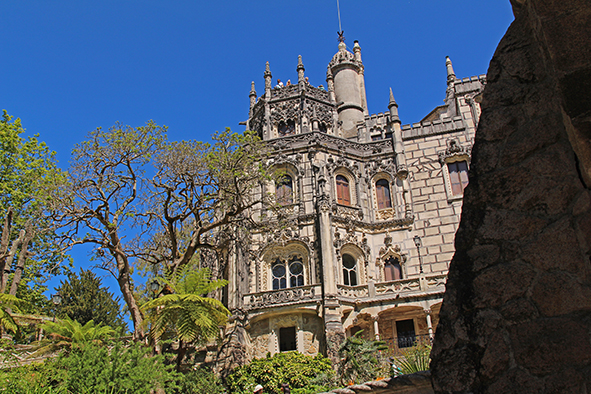
Quinta da Regaleira Palace in Sintra (Photo: Paul Stafford)
Winding Roads
After waiting 30 minutes for the bike to be calibrated over a coffee and delicate pastel de nata I was able to hook my feet into the toe clips and set out. The descent back into town took me past terracotta-roofed buildings covered in wisteria and shaded by chestnut trees. The road twisted and wound its way along the contours of the landscape, with little tributaries firing off in all directions. At the other side of the central square I passed a palace, one of many, which I believed to be marked on the map, and began a steep and winding descent down into the open country.
The sense of foreboding about the climb back up I would have to make did not really set in until I reached a main road, the likes of which I had been told to avoid. After only 15 minutes I had made a costly error and taken the wrong winding road past the National Palace. The wrong palace. The climb back up was a tedious one. In the lowest gear I strained my way up to Sintra in the late morning heat. Back in town I took two more wrong turnings before finding the correct road. And Quinta da Regaleira, the correct palace.
Even in high summer this part of the Iberian Peninsula remains one of the most fertile, as warm, moist fronts sweep in from the Atlantic Ocean. Walls and rocks are soon covered in thick green moss, like layers of protective padding. The air had a deep earthy scent to it. Epiphytes hung down from branches of lofty trees and flowers bloomed in the least expected outcrops amidst the greenery. Everything was so immaculately organised and cared for.

Gardens outside the Palace of Monserrate in Sintra (Photo: Paul Stafford)
Where the Moors and Brits Meet in Portugal
My first stop was to be the Palácio de Monserrate. “It’s just outside Sintra”, I had been told. In actuality, after the climb back into town the 5km it took to get there from town felt tripled. The road either went up or down, never flat. There was rarely enough space for two cars to pass. More than once I found myself forced to stop midway up an incline for a car that had pulled into a lay-by to let another pass. Starting again mid-incline was gruelling and by the time I reached Monserrate, sweat was pouring off me like I’d been oiled up for a swimwear photo shoot.
“Breathe” said the man at the ticket kiosk as I hobbled up to pay entry.
“Easy for you to say” I replied taking my ticket.
I ambled through the extensive gardens of the palatial villa. Ordered built by Sir Francis Cook, a British merchant, he enlisted architect James Thomas Knowles to combine the unique brand of Sintra Romanticism with Moorish Stucco design to reflect the important influences on the region in the architecture. This is especially felt in and around the main palace; the many fountains and water features were considered a sign of wealth and power by the Moors, coming as they did from desert regions.
The interior of the building was airy and shaded and for the first time since getting off the bike I felt a sense of reprieve. The design of the main dome was exquisite, employing a mostly floral motif that found harmony with the well-kept gardens spreading out from the palace on all sides.
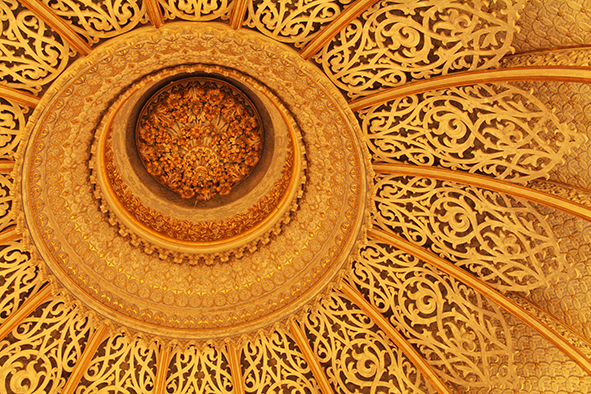
Gorgeous decoration of the interior of the Palace of Monserrate (Photo: Paul Stafford)
Two Wheels, Better Than Two Legs?
Inevitably it was not long before I was saddled up and ready to pedal again. I drank some more water, hoping to ration what little remained until reaching a village where I could buy more. The going got steadily tougher, but the surrounding views as the land slipped steeply away down to the Atlantic and Cabo da Roca – the most westerly point of the European mainland – increased in spectacularity. The road undulated and the sun was doing what it does best, the two combining to sap the energy from me.
After quite a push and another couple of wrong turns I eventually made it to the village of Penedo and, more importantly, the Refúgio do Ciclista. I plonked myself down under a big red parasol and ordered two bottles of water. The cheerful waiter sat down opposite me and lit a cigarette. “Tough going today I imagine,” he said, laughing at my expression.
I polished off the first bottle and cracked the second. “Great cycling around here though. We get plenty of people through here, but they usually go for the electric bikes these days.”
“Those people are wiser than me.” I had underestimated my fitness levels. I had one last push to the top ridge of the Sintra Mountains then it would be much easier going from there. Feeling mildly rested I clambered back onto the bike and set off uphill, leaving the waiter and his “good luck” behind.
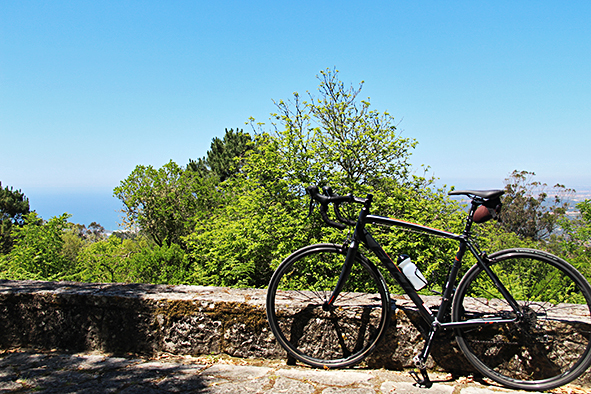
The bike at the top of the Sintra Mountains looking out towards the Atlantic (Photo: Paul Stafford)
Halfway up the ascent both of my thighs developed cramp at exactly the same time. It came on with a sharp twinge, the excruciating nature of which was only mediated by the fact that it wasn’t just coming from one place in my body. It was safe to say that I hadn’t really prepared myself very well. My bike immediately came to a halt on the steep country road, fringed on either side by high hedges. I couldn’t move and so remained immobile, hoping no cars would come screaming round the corner.
To anybody who may have chanced to see me at this moment, the following would have looked Chaplinesque. Legs still cramped into a 90 degree angle at the knee I tried to swing off the bike. I let the bike drop and stood there almost squat and tried to walk around, moving ever so slowly until the cramp began to ease. Once it had receded enough to walk relatively normally I picked up the bike and wheeled it to the top of the hill, from which I was fortunately not far. Once there the road was flat for the first time in the entire trip, so I cycled as gently as possible, marvelling at the expansive, yet slightly hazy views down to the Atlantic.
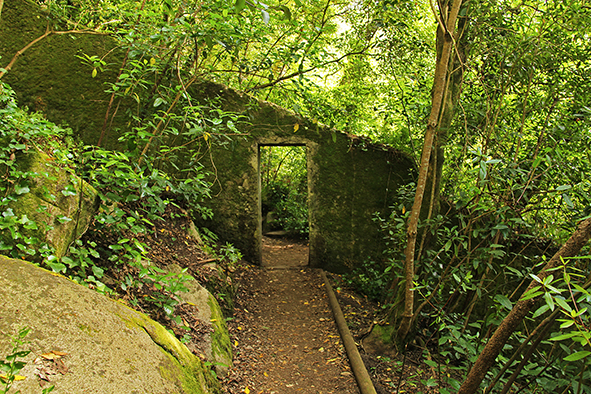
Steep wall in the gardens at the foot of the Moorish Castle, Sintra (Photo: Paul Stafford)
Penance
By inches I came to the Convento dos Capuchos. I swung off the bike and walked around, being careful not to do any serious stretching for fear of exacerbating my cramp. The Convent blended seamlessly into the surroundings; it was unclear whether it had been designed that way or was simply being reclaimed by nature. I hadn’t the energy to explore further. I had already done my penance. So I sat on a peaceful step listening to the stillness. I almost thought I could hear the waves of the Atlantic some miles away.
At the gate I bumped into two tired looking cyclists dismounting from their electric bicycles. “How are they?” I asked.
“Amazing. We couldn’t have done this without the electric support,” said the young Canadian guy as he removed his helmet and shook out his straggly blonde hair.
“Me neither,” I said, looking wryly at the road bike I hoped would get me the 9km back to the rental shop. It was a fortunate thing that the way was much flatter, with quieter, wider roads on the return. Tall pine trees at this elevation rose up above the road like a church nave. Every now and then I would get a glimpse through the trees of one elegant palace or other ensconced in the folds of the mountains, away from the feet of tourists. Many of these elegant buildings remain reclusive retreats for the wealthy, despite those that are more central to Sintra town being heaped with adulation.
I willed my legs to push up the final hill, they replied with every ounce of strength left to get me over and onto the series of hairpin bends that wheedled their way back to town, despite their menace to anybody cycling uphill.
“How was it?” asked the fellow back at the bike rental shop.
“Absolutely fine,” I lied, trying not to show how tough I was finding walking at that moment. But then again I could have been talking about the Natural Park. It might have been a little more than “just outside Sintra,” but it was packed with the mystery and magic that often only existed at the end of the pens of fantasy writers. That was worth every bit of effort to see, cramp and all.

Private Home seen from the lower ramparts of the Moorish Castle, Sintra (Photo: Paul Stafford)

Yellow turrets and a Moorish castle are immediately visible when stepping off the train (Photo: Paul Stafford)

Water fountain outside the Palace of Monserrate (Photo: Paul Stafford)